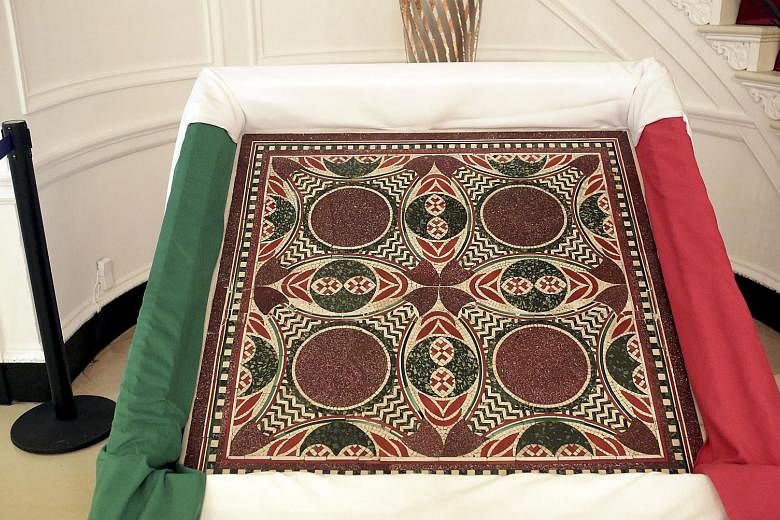NEW YORK • A piece of mosaic flooring from one of Roman Emperor Caligula's ornate ceremonial ships, which was stolen after World War II, is on its way back to Italy from the United States, where it was used as a coffee table in an antiques dealer's Park Avenue apartment.
Now, investigators for the Manhattan district attorney's office are trying to sort out the journey of the 2,000-year-old piece of Roman history that was once dredged from Lake Nemi outside Rome and somehow ended up in a private home in New York City.
Last month, prosecutors seized the mosaic, saying they had evidence it had been taken from an Italian museum before World War II. Last Thursday evening, the piece was returned to the Italian government at a ceremony, along with two other recently recovered antiquities.
"These items may be beautiful, storied and immensely valuable to collectors," district attorney Cyrus Vance Jr, said in a statement, "but wilfully disregarding the provenance of an item is effectively offering tacit approval of a harmful practice that is, fundamentally, criminal."
Antiques dealer Helen Fioratti said she and her husband, journalist Nereo Fioratti, had bought the mosaic in good faith in the late 1960s from a member of an aristocratic family. The sale was brokered, she said, by an Italian police official famed for his success in recovering art work looted by the Nazis.
"It was an innocent purchase," she said in an interview. "It was our favourite thing and we had it for 45 years."
Ms Fioratti, who owns L'Antiquaire and the Connoisseur, a noted gallery for antiques from Europe in East 73rd Street, said she did not intend to fight the seizure because of the expense and time it would take.
Still, she said she believes she has a legitimate claim to ownership. "They ought to give me the legion of honour for not fighting it," she said.
No charges were filed against her last Thursday, though the search warrant said investigators were looking for evidence to support a charge of possession of stolen property.
The square piece of marble flooring - which features a complex geometric pattern made of pieces of green and red porphyry, serpentine and moulded glass - dates back to Caligula's reign, AD37 to 41, and came from one of three enormous ships that he had built at Lake Nemi, a circular volcanic lake where there was once a temple to Diana, the goddess of the hunt.
"They functioned as artificial floating islands, where the emperor could retreat, being completely separated from the world," professor Francesco De Angelis of art history at Columbia University said in an e-mail message.
After Caligula was assassinated, the ships were sunk and remained underwater for centuries.
Italian leader Benito Mussolini began draining the lake in 1929 and by 1932, two of the ships had been located and hauled ashore.
In 1936, the Fascist government built a museum to display the artefacts, including the complete mosaic and a few other smaller fragments, according to experts.
At the end of the war, however, partisans opposed to the government set fire to the museum.
Manhattan prosecutors believe the mosaic was taken from the museum before the fire because it shows no sign of damage like the other fragments.
In 2013, an Italian expert on ancient marbles, Mr Dario Del Bufalo, published a monograph about the Roman's emperor's use of red porphyry, a blood-coloured stone associated with power.
To promote his book, he gave a talk in New York attended by many art historians and dealers.
He said he showed the assembled experts a photo of the mosaic that had been taken at a gallery in Rome in the 1960s, a rare sighting of the stolen work.
Ms Fioratti and her husband had never tried to hide the mosaic and there were people in the audience who had seen it in their home, Mr Del Bufalo said in an interview.
Reports of its whereabouts in New York eventually reached the authorities, he said.
NYTIMES, REUTERS

